Measuring the hallmarks of ageing – how can you track the underlying causes of ageing?
What consumer tests are available to check your hallmarks of ageing and how they're impacting your body?
Join the club for FREE to access the whole archive and other member benefits.
NAD, along with its precursor supplements NMN and NR, is a hot topic in longevity research and with life extension enthusiasts. It plays an essential role in multiple cellular processes such as energy production, DNA repair, and immune activation.
Scientists are still learning how the multiple pathways to generate NAD work, whether they work differently in different organs and different people, and all of the ways it is consumed. But just because it’s not yet fully understood, doesn’t mean you can’t check how much of it you have.
To steal a quote from the business world – “if you can’t measure it, you can’t improve it.” But luckily, it is possible to measure it, so you can check whether the supplements you’re taking are working for you.
Last year, I carried out my own N=1 trial of NMN using blood and physical biomarkers as correlates NAD levels. This year, I wanted to see whether NR would have a similar affect. As well as taking similar measurements, I’ve been fortunate to have been donated two intracellular NAD test kits from Jinfiniti. This means I can measure the before and after situation of my actual NAD. I’ve just finished the trial period, and sent off my second NAD test, so keep an eye out for the blog post coming soon.
As well as providing the test kits for this blog, Jinfiniti are also offering club members a 15% discount on the test – see the members discount page for details. TL DR? I’d recommend getting one!
NAD stands for nicotinamide adenine dinucleotide – an essential molecule that takes part in over 400 enzyme-enabled chemical reactions including those involved in the production of cellular energy (ATP).
It is an important cosubstrate for three classes of enzymes involved in cellular signalling:
1. Sirtuins (SIRTs)
2. Poly(ADP-ribose) polymerases (PARPs)
3. Cyclic ADP-ribose (cADPR) synthases (CD38 and CD157)
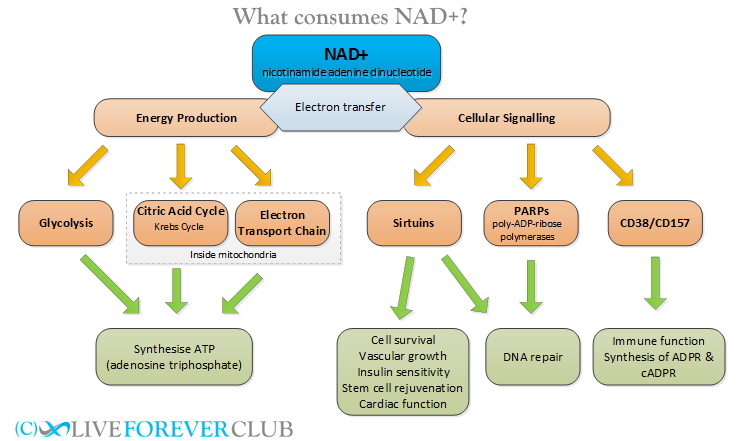
Given its importance, it’s no surprise that there are multiple sources of NAD for the body to rely on. Two of these create new NAD+ (synthesized from diverse dietary sources) and the third reclaims spent NAD+:
De novo biosynthesis is an academic way of saying “created new from a biologic process.” The initial building block is tryptophan from your diet - good food sources include milk, tuna, poultry, oats and nuts. However, most people get more tryptophan in their diet than the recommended guidelines, so this doesn’t seem to be a limiting factor in NAD+ production.
We don’t need to understand the details here, but in summary, the steps from tryptophan to NAD+ are:
Although quinolinic acid is the final step in the de novo biosynthesis pathway, this is converted into nicotinic acid mononucleotide (NaMN) halfway through the Preiss-Handler pathway which we look at next.
The Preiss-Handler pathway kicks off with niacin – also known as nicotinic acid (NA) or more simply vitamin B3. A number of enzymes are involved in a few steps for its conversion to NAD+:
Good food sources of niacin are meat, fish, avocados and wholegrains. Peanuts get a special mention as you can get a third of your daily needs from just 2 tablespoons of peanut butter, though for an even bigger boost a tablespoon of nutritional yeast gives twice the daily recommended allowance. As well as feeding into the NAD+ salvage pathway, it is important for the nervous system and also functions as an antioxidant.
So, do you have to consume foods rich in tryptophan and niacin 24 hours a day to keep the supplies up? No, because the third source of NAD+ is the salvage pathway, where spent NAD+ goes through a few steps to be recycled.
This is the key pathway for maintaining cellular NAD+ levels because it would be impossible to consume enough through the dietary pathways described above. And cells would die in about 30 seconds without NAD+ so the body can’t rely on a continuous external supply.
Whether used up by sirtuins, PARPs or CD38, a by-product of NAD+-consuming enzymes is nicotinamide (NAM, also known as niacinamide). This is not discarded by the body, but goes through a few steps to be restored to NAD+:
Not only does the body need the NAD+ that is regenerated from NAM, it’s also good to use up the NAM which otherwise builds up and inhibits activity of sirtuins.
No doubt a couple of these precursors, NMN and NR, will sound familiar as popular NAD boosters. These are some of the few supplements that are going through clinical trials and therefore worth keeping an eye on.
Here’s how these three NAD+ pathways look in a diagram, courtesy of research by Eric Verdin.
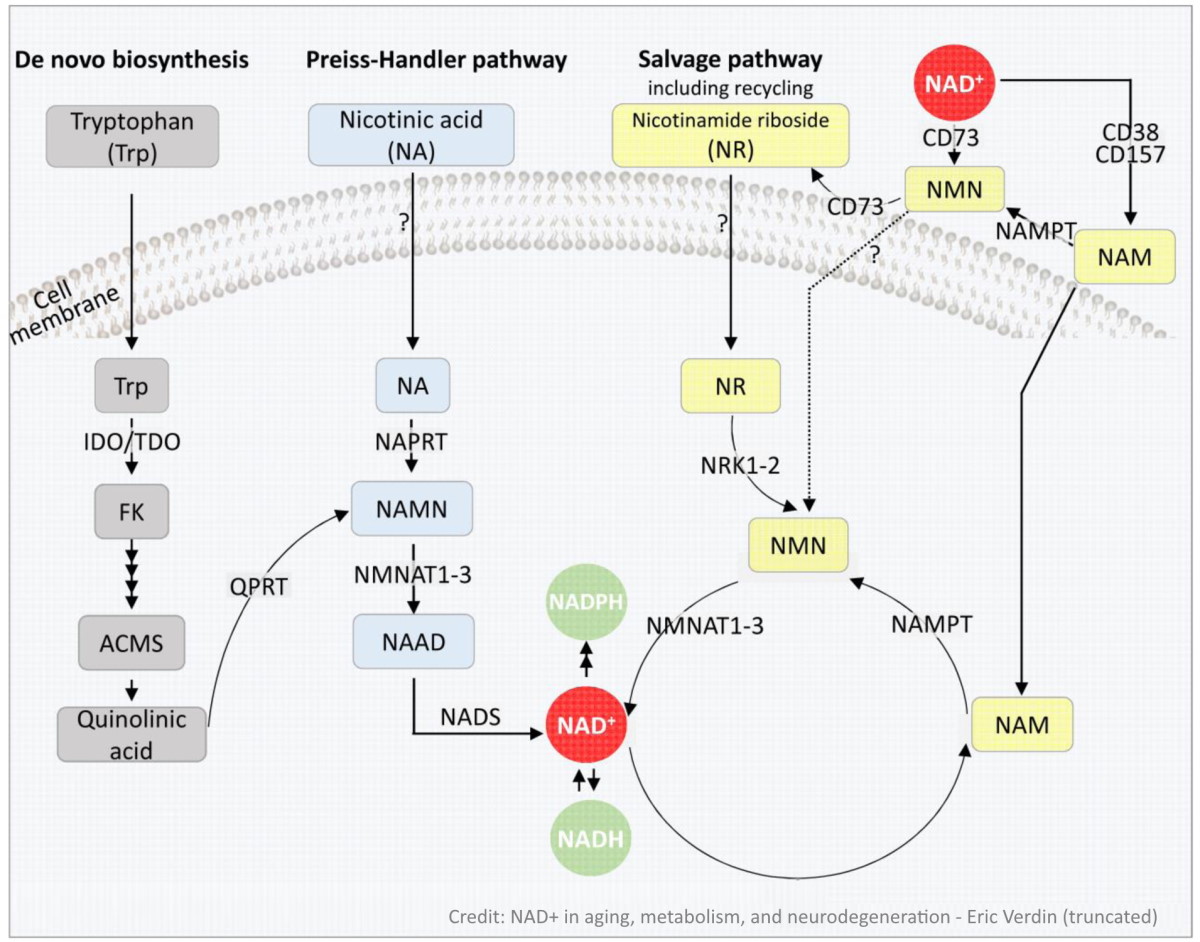
NADH is the reduced form of NAD+ - that’s the chemistry way of saying that when NAD+ gains electrons, it becomes NADH (H for hydrogen). But both are considered to be NAD.
NAD+ is a carrier molecule that traps electons (e-) and protons (H+) and transfers them to where they are needed in the cell. Both electrons and protons actually come from pairs of hydrogen atoms, but the simplified chemical formula is:

Here’s a great explainer video by Biology Bugbears: https://www.youtube.com/watch?v=bV5Kg-UklYY
Jinfiniti Precision Medicine was founded by Dr. Jin-Xiong She in 2018. He still teaches and runs a lab at Medical College of Georgia, Augusta University, which researches disease mechanisms and biomarker discovery, with a focus on high throughput drug screening, cancer biomarkers, human & mouse genetics, functional genomics and proteomics, as well as running the The Environmental Determinants of Diabetes in the Young (TEDDY) clinical trial.
Dr. She is also Eminent Scholar Chair in Genomic Medicine, Center for Biotechnology and Genomic Medicine – so I’m happy to assume he knows his stuff!
While trying to identify risk factors for diseases, he concluded that the biggest risk factor is ageing. Likewise, although the Jinfiniti team started out developing a new cell culture technology, its focus is now on ageing, and particularly actionable blood tests. “Actionable” meaning you can do something to change the result, either by altering your lifestyle or taking supplements, or even better to identify personalised therapies.
It's also good to see that the company’s goal is to democratise personalised healthcare, which aligns with the club’s philosophy of equality in longevity. One of the ways Jinfiniti is trying to do this is with high-throughput analysers, allowing hundreds of samples to be tested at a time, and therefore reducing cost.
Jinfiniti offers two types of NAD test:
This blog reviews the intracellular NAD test, which is the cheapest of the two and is aimed at repeat testers who want to see the impact of any lifestyle changes on their NAD levels.
Confusingly, both tests are blood tests! The intracellular NAD (icNAD) test uses a standard blood spot (finger prick onto filter paper), but as the concentration of NAD inside white and red blood cells is 60-80 times that in the plasma, that is what the result reflects. It measures the combined NAD+ and NADH level at the time the blood sample was taken.
NAD is naturally subject to rapid degradation at room temperature, so Jinfiniti has developed a preservation protocol that allows it to remain stable at room temperature for weeks – long enough to post the sample back internationally.
The NAD in blood plasma (i.e. the circulating NAD) comes from secretions by cells all over the body, so gives a broader picture of NAD health than the intracellular test. The circulating NAD test (part of one of the company’s AgingSOS panels) is also a finger prick, but requires many more drops to fill up a small vial. It also needs to be received by Jinfiniti within 48 hours so probably isn’t suitable for people outside of the US.
Some home tests turn up in a hipster-style box with someone receiving a design award for making it look so appealing! The Jinfiniti test, on the other hand, turned up in a padded envelope and an A4 print out for instructions. Luckily, I only really care about the science, so if they’re saving money by not paying someone to think outside the box – even though they’re designing a box – then that’s fine with me :)

The test requires a few drops of blood on a piece of filter paper, so it’s no surprise that the kit includes the standard set of lancets, plasters and alcohol swabs.
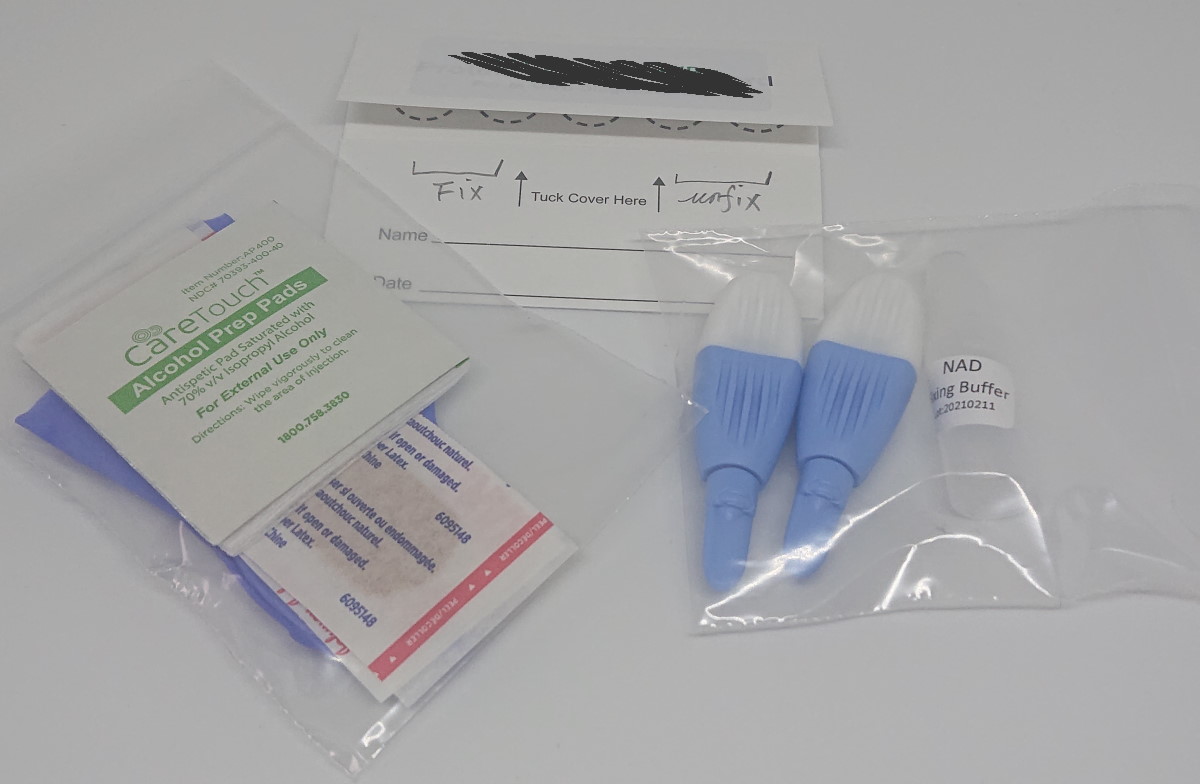
In addition to that, it contained a filter paper card, and a small vial of fixing agent.
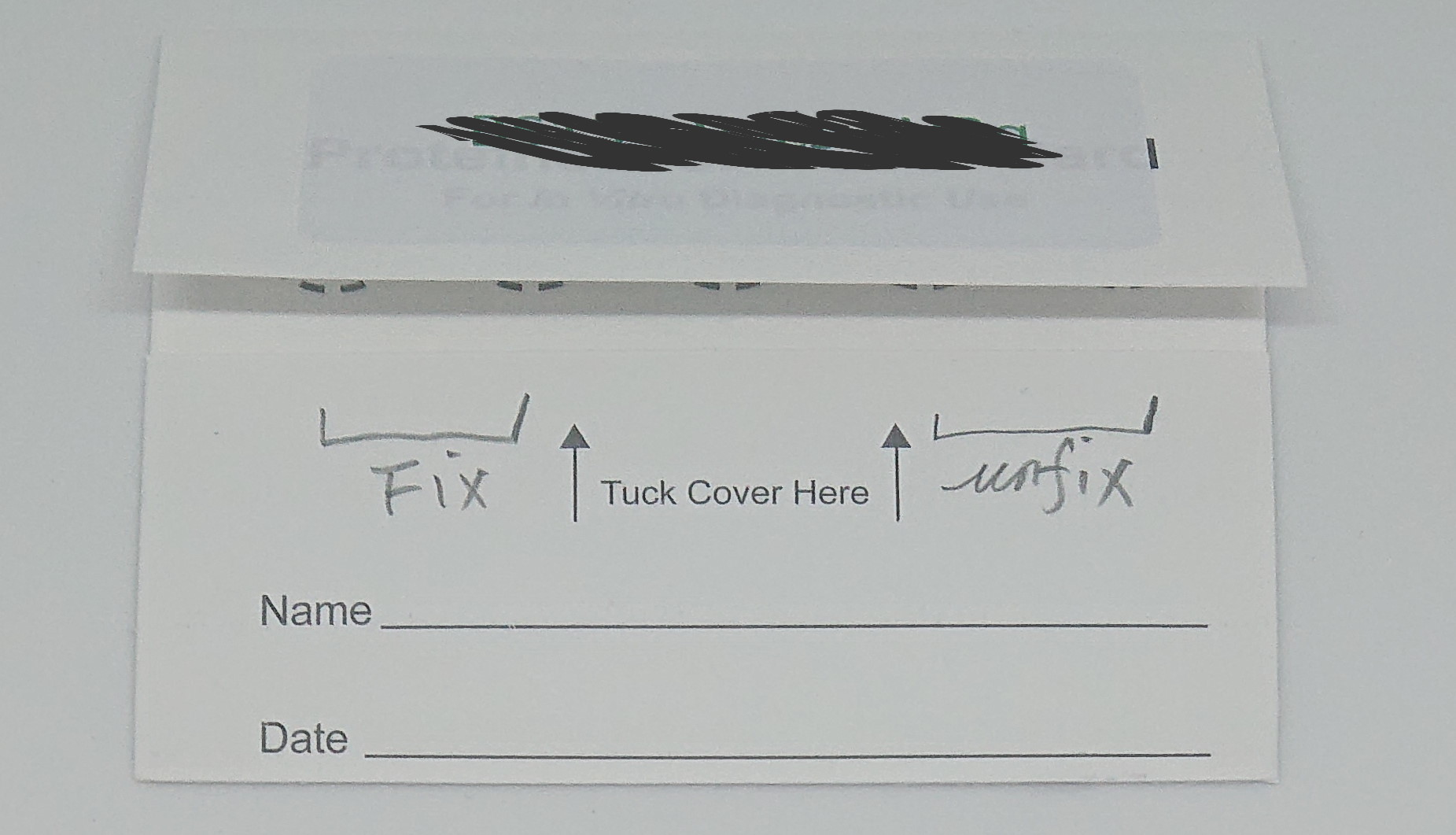
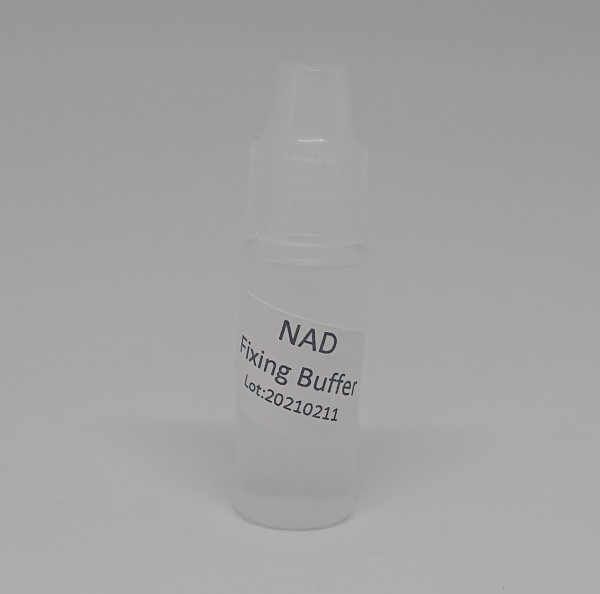
Before getting started I had to register the kit – a simple process on the Jinfiniti website, just needing the code from the front the filter paper card (redacted in my images). There was also a small questionnaire to check if you are currently undergoing any anti-aging interventions or taking NAD-related supplements.
Having done that, it was time to open the card and have a look inside:
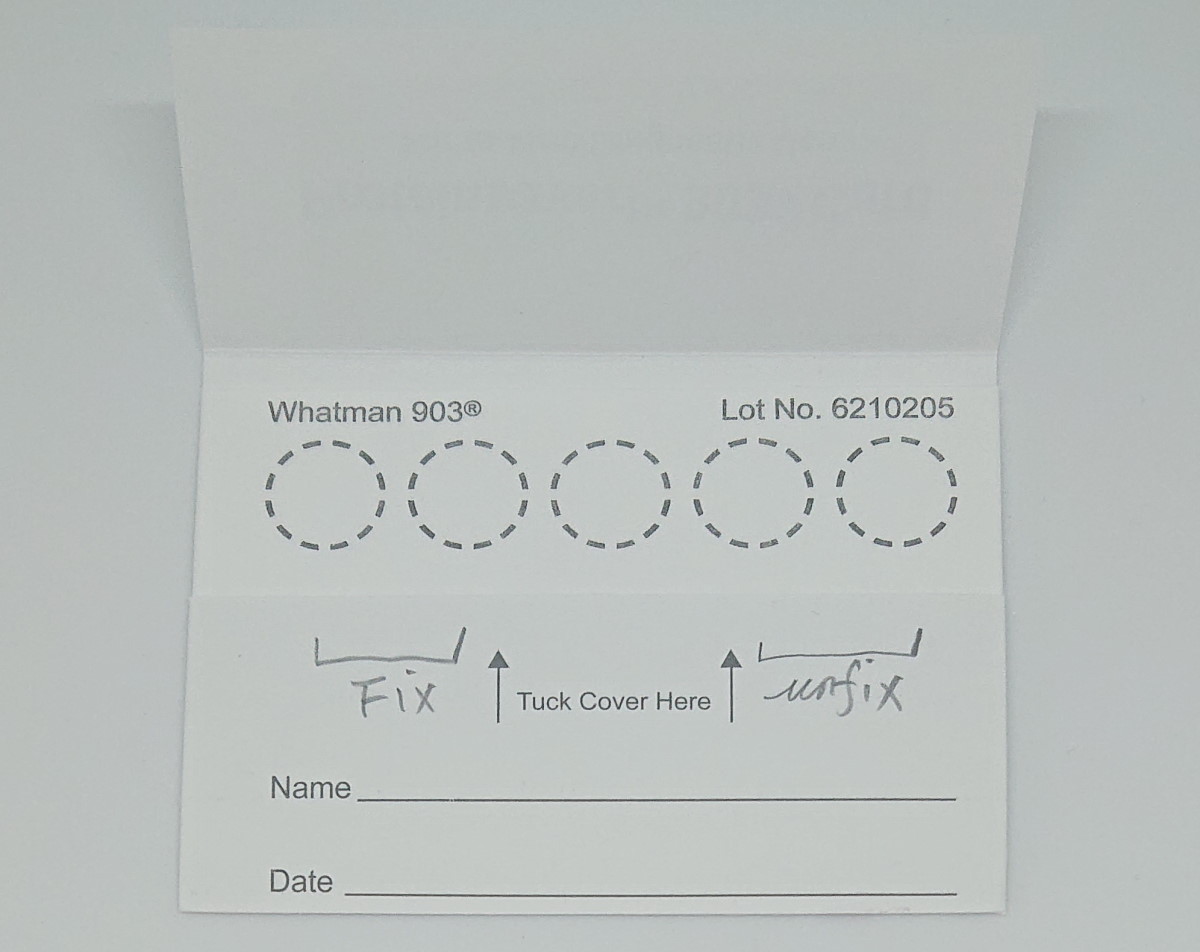
The most important thing was to avoid touching the sample area to make sure the sample doesn’t get contaminated. Then, the plan is to use the lancet to produce blood drops and fill up the fix and unfix sample areas (4 out of 5 circles). However, the instructions make clear that it is more important to get one good “fix” circle then half complete all of them.
I often worry whether I’ve taken the sample correctly, so it was useful that the instructions had an example of what would be unsatisfactory:

Fortunately, I recently got the hang of getting a good flow of blood out of a simple lancet prick so had no problem filling up the four filter paper sample circles:
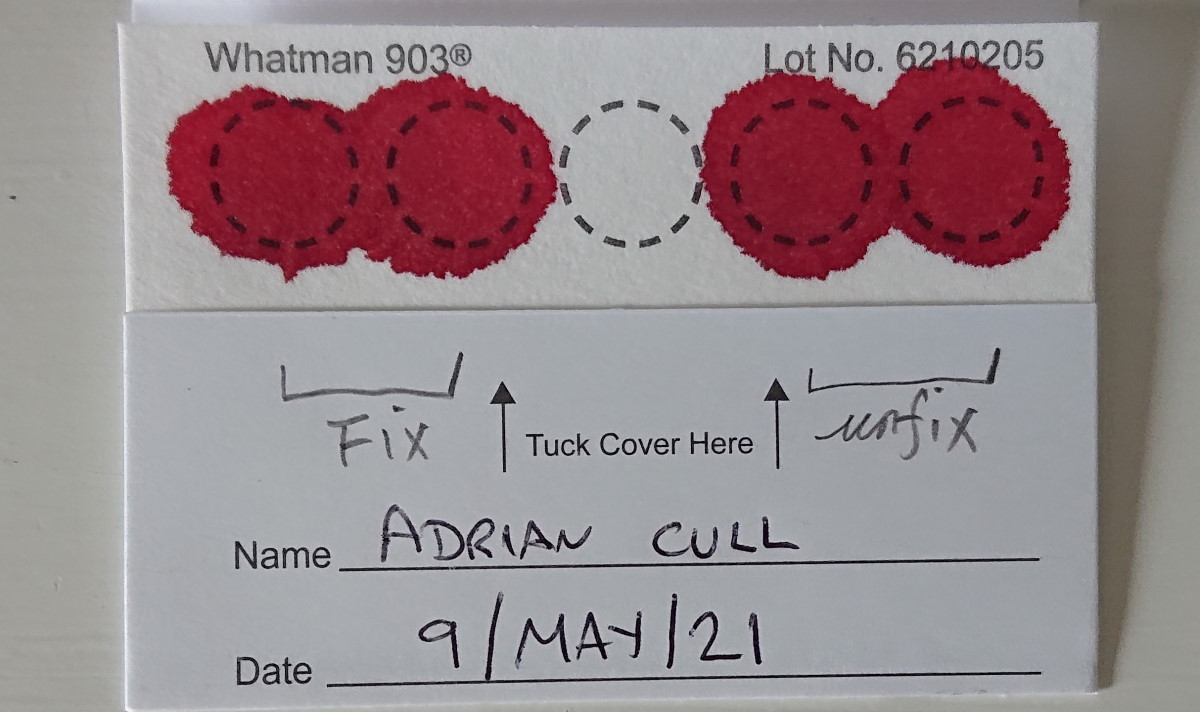
The samples have to dry out, at room temperature, for a few hours, before applying the fixing agent to the first two specimens. You let that dry for 5 minutes, then apply some more fixing agent:
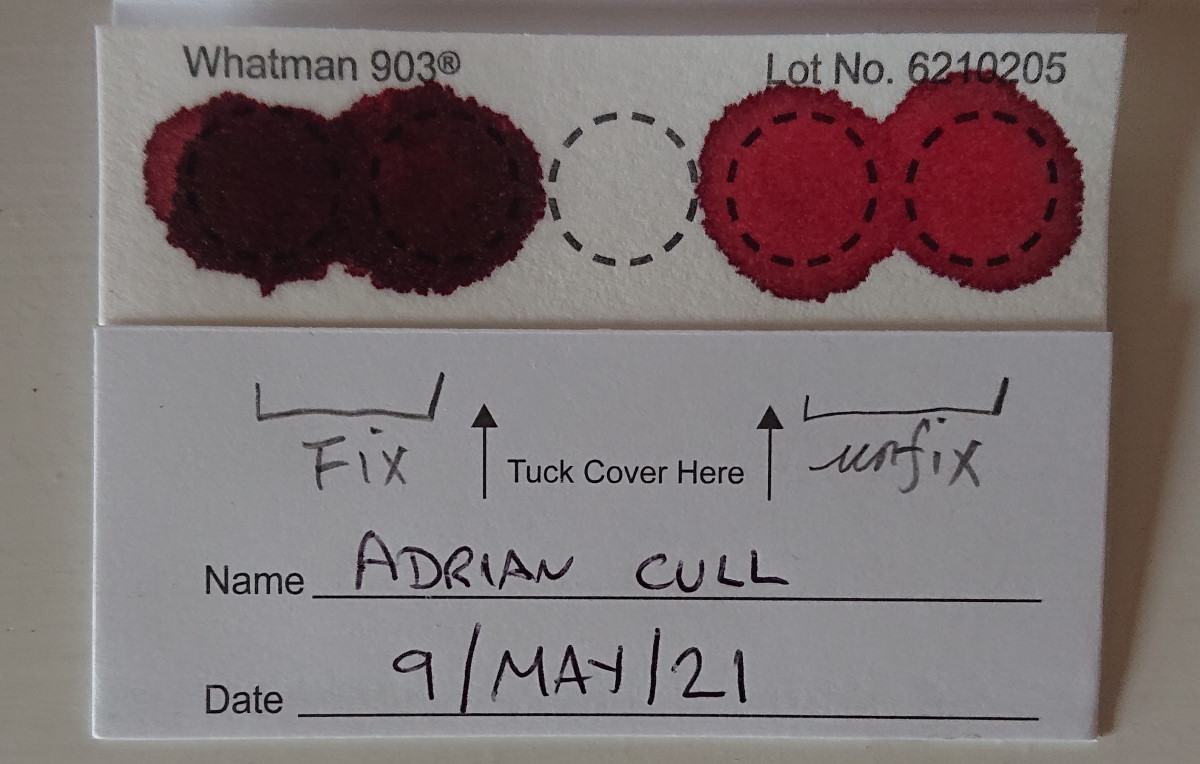
Done. Now to return it to Jinfiniti in the US. I took a bit of time checking whether I could send biological samples by post (will write up my research some time) and fortunately dried blood spot (DBS) samples are excluded from the biological substances regulations so I was able to send using standard Royal Mail international.
It took a week for the sample to arrive at Jinfiniti’s lab, but only a couple of days for them to provide the result after that. The result comes in a downloadable report that provides some useful information on what NAD is, and the interplay between genes and modifiable factors.
And my result was… 26.0 μM.

The unit, μM, is micromolars, which is a measure of the chemical concentration of a solution.
Jinfiniti has defined four bands of NAD health:
Dr. Jin-Xiong She has mentioned in an interview that there is no clear science, yet, to define of a normal range for NAD but the upper 25 percentile of youthful levels seemed a reasonable target.
That means that I am on the border between sub-optimal and deficient, which is not great, but perhaps normal for someone of my age (51)? Especially as, according to research by University of New South Wales, by middle-age NAD levels drop to around 40% of their young adult level.
Though, saying that, the report does note that levels between 30-50uM are commonly seen in both young and old people, so over 30 μM seems like a good target for someone in their 50s like me, particularly as a life extensionist who wants my scores to be competitive with youthful counterparts.
So I could definitely do with boosting my NAD levels and am currently undertaking a trial of NR (nicotinamide riboside) – this test was taken at the beginning, and I’m doing another one at the end, so it will be very interesting to see how much it has changed.
I could (and should) probably write a whole blog post on how to improve NAD levels, but for now, here’s a quick summary of things to consider. Think about the way NAD is created and consumed, and there are three main areas that can help boost NAD levels:
The main focus at the moment is increasing the source of NAD with supplements, either with tryptophan or niacin to create NAD directly, or with NR or NMN (nicotinamide mononucleotide) which are NAD precursors used in the salvage pathway. All of these supplements will behave differently for different people, and whether they work at all is still waiting for definite proof, hence it is worth testing your NAD levels regularly to see what works for you.
Second, as explained at the beginning, NAD is critical for many cellular functions, some of which we have a little control over. As we age, more sirtuin and PARP activities take place to maintain cellular health, and inflammaging causes more NAD depletion via the CD38 enzyme. So by following normal healthy lifestyle advice, which should reduce your biological age, these molecular activities should be reduced and therefore use up less NAD. Fasting, calorie restriction and exercise have all been seen to raise NAD+ levels.
Finally, it may be possible to stimulate enzymes that produce or recycle NAD, but this is in the early research stage so nothing that can be done in practice in this area yet.
Dr. Jin-Xiong She has pointed out that it takes 2-4 weeks to boost NAD with supplements, and if you’re not seeing a different after 4 weeks then that particular supplement probably won’t work for you, so try another as everyone’s body works differently. Once raised, NAD levels are relatively stable, so it doesn’t matter if you forget to take them for a few days. Your NAD levels are likely to take 4-6 weeks to drop back down after any intervention.
It’s not known yet what concentration of NAD could be toxic or have a deleterious effect, so for now it’s probably best to follow the catch-all advice – everything in moderation. There almost certainly will be an upper limit to beneficial NAD levels, and over supplementing or IV transfusions could make you exceed it. Although SIRT1 activation is clearly protective in terms of metabolism, its increased activity might pose considerable risk in other organs, for example putting susceptible individuals at increased risk of autoimmune diseases or promoting tumour development.
Given the importance of NAD to so many critical cellular functions, it does seem to be a key biomarker to track along with a standard blood panel. And to really personalise your longevity strategy, you need to be able to test and review regularly (i.e. more than once a year).
Jinifiniti have made their intracellular NAD test cheap and easy to use which means it can be used to track NAD levels over time to monitor the impacts of any interventions - supplements, lifestyle, or just getting older.
P.S. don’t forget Jinfiniti are offering club members a 15% discount on the test – see the members discount page for details.
NAD LEVELS - How We Test & Decide The Optimal Range | Prof Jin-Xiong She Interview Series Episode 2 - Modern Healthspan
NAD+ in aging, metabolism, and neurodegeneration - Eric Verdin, Science Dec 2015
NAD+ and FAD+ Cofactors – AK Lectures
Age-Associated Changes In Oxidative Stress and NAD+ Metabolism In Human Tissue – Guillemin, PLOS ONE Jul 2012
Top Foods High in Tryptophan - WebMD
16 Foods That Are High in Niacin (Vitamin B3) - Healthline
Click on resource name for more details.
Club discount available - click here
Provides at-home intracellular NAD test and other aging blood panels
Founder and CEO, Jinfiniti Precision Medicine and Director of the MCG Center for Biotechnology and Genomic Medicine,
TruAge (TruMe) Biological Age Test Review
What Happened to Plain-Old Biology?!
What consumer tests are available to check your hallmarks of ageing and how they're impacting your body?
A good jump in NAD levels and grip strength during this one month trial, but not everything improved
What is the impact on physical biomarkers from taking spermidine supplements?
2 month trial of nicotinamide riboside NAD booster Tru Niagen